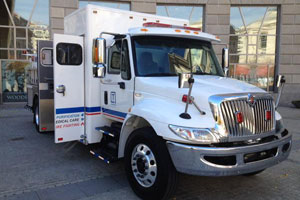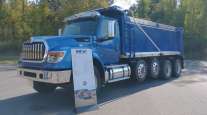Navistar, Terranova Develop Truck to Assist in Disaster Relief Efforts

This story appears in the Dec. 1 print edition of Transport Topics.
WASHINGTON — Navistar Inc. and specialty vehicle distributor Terranova GTS have introduced a truck designed for versatility in aiding disaster relief efforts around the globe.
The Multi-Purpose Vehicle, or MPV, is a medium-duty International DuraStar model outfitted with a water purifier, firefighting equipment and a mobile medical unit.
Tom Clevinger, senior vice president of Navistar’s global truck and bus business, described the vehicle as the “first of its kind in the industry.”
“We’re proud to have developed this versatile, multipurpose vehicle, and we’re excited about its potential impact to provide humanitarian aid and support for crises around the world,” he added.
The companies unveiled the new truck here Nov. 19 at the Aid and International Development Forum’s Disaster Relief Summit.
The systems and equipment installed on the vehicle enable it to serve as a fire truck, ambulance and mobile water-treatment system, all in one.
Navistar said the MPV was designed to address needs, both in response to natural disasters, such as floods and earthquakes, and planned activities such as water supply and medical campaigns.
Navistar said the truck’s water-treatment system removes particulates, turbidity, bacteria, viruses and cysts from “virtually any water source” and can purify up to 5,000 gallons of drinking water a day.
The MPV is available through a marketing and distribution agreement with Terranova, a company founded recently by Bernardo Valenzuela, a former Navistar employee.
During his time at Navistar, he was vice president of global operations, responsible for the truck maker’s business in Latin America, Africa, the Middle East, Russia and China.
Valenzuela said the MPV’s three-in-one functionality was inspired by his trips to developing nations, where he saw a “tremendous” need for clean water and a lack of adequate emergency equipment, a problem that was made clear when he saw an ill person riding on top of a fire truck to reach a shelter.
“I saw a dramatic need for this sort of vehicle,” he said.
By combining water purification, medical care and firefighting, the MPV has the potential to improve quality of life in many places around the world, Valenzuela said.
In addition to responding to disasters, the vehicle also can function as a stationary water-bottling factory, he said.
Valenzuela said Terranova soon will deliver its first MPVs in Latin America and next plans to focus on its strategy for the African market.
Although the company plans to sell the vehicle around the globe, it also sees a market for the MPV in the United States, he said.
Valenzuela said the target customers for the MPV include governments, municipalities, non-governmental organizations and even corporations, such as mining or oil field companies.
The truck showcased at the AIDF Summit was a Class 6 vehicle with a MaxxForce DT engine and an Allison automatic transmission.
The vehicle, which is available for order, costs about $250,000, depending on the types of equipment specified for the truck, Valenzuela said.
While very expensive for a single vehicle, it offers savings from building multiple fleets.
Navistar spokesman Steve Schrier said the MPV price is generally about a third of the total cost of purchasing a fire truck, an ambulance and a water-purification vehicle independently.
Terranova is working with Chicago-based equipment supplier W.S. Darley & Co. to outfit the MPV with its water pump, tank and purification systems.
Kevin Sofen, business development manager at Darley, described the vehicle as “a single asset that can perform multiple functions and has a wide array of applications.”
Domestic fire departments are called upon to respond to a variety of emergencies, many of which aren’t fire-related, so they are looking to expand their capabilities in fields such as medical aid, Sofen said.
“We believe it’s the direction of the first responder industry,” he said.




